Andersen Corporation Bundle
Who Really Owns Andersen Corporation?
Ever wondered about the driving force behind one of North America's largest window and door manufacturers? Understanding the Andersen Corporation SWOT Analysis and its ownership structure is key to grasping its market position and future trajectory. Founded in 1903, Andersen Corporation's story is a fascinating blend of family legacy and strategic evolution.
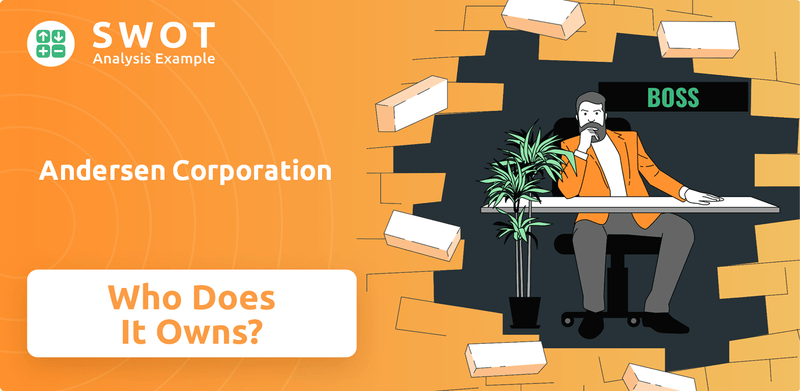
This exploration into Andersen Corporation ownership unveils more than just names; it reveals the core values and strategic vision shaping the company. From its humble beginnings as Andersen Lumber Company to its current status, knowing who owns Andersen Windows provides critical insights. Delving into the Andersen Windows owner and its history offers a comprehensive understanding of this industry leader.
Who Founded Andersen Corporation?
The story of the company began in 1903 as the Andersen Lumber Company, founded by Hans Jacob Andersen, a Danish immigrant, along with his wife and children. They initially focused on lumber, taking advantage of the logging boom along the St. Croix River. Hans Andersen's prior experience in the lumber industry set the stage for the company's early ventures.
A critical moment occurred when Hans Andersen chose not to lay off his workers during the off-season. This decision led him to leave his previous position and establish his own retail lumberyard, employing the same workers, including his sons, Fred and Herbert. This move highlighted a commitment to his workforce that would become a hallmark of the company.
The shift towards manufacturing standardized window frames was a game-changer. In 1905, the 'two-bundle' method was introduced, standardizing window sizes and enabling mass production, a novel concept at the time. Early sales were successful, bringing in $74,000 in its first year, a significant achievement for the young company. By 1913, the company had expanded, constructing a factory in South Stillwater (now Bayport, Minnesota).
Hans Jacob Andersen, along with his wife and children, founded the company in 1903.
Initially, the company focused on lumber, taking advantage of the logging boom.
Hans's decision not to lay off workers led to the creation of his own retail lumberyard.
The 'two-bundle' method, introduced in 1905, standardized window sizes for mass production.
The window frame business generated $74,000 in its first year.
After Hans Andersen's death, Fred Andersen became president, and Herbert Andersen took on various leadership roles.
The ownership of the company has historically been primarily held by the Andersen family. Understanding the Andersen Company history provides insights into its evolution.
- The Andersen family has maintained significant control over the company since its inception.
- Employee ownership has been a part of the company's structure, with approximately 27% of the stock held by employees.
- This ownership structure reflects a commitment to both family legacy and employee engagement.
- The company's early success and growth were driven by the Andersen family's vision and strategic decisions.
Andersen Corporation SWOT Analysis
- Complete SWOT Breakdown
- Fully Customizable
- Editable in Excel & Word
- Professional Formatting
- Investor-Ready Format
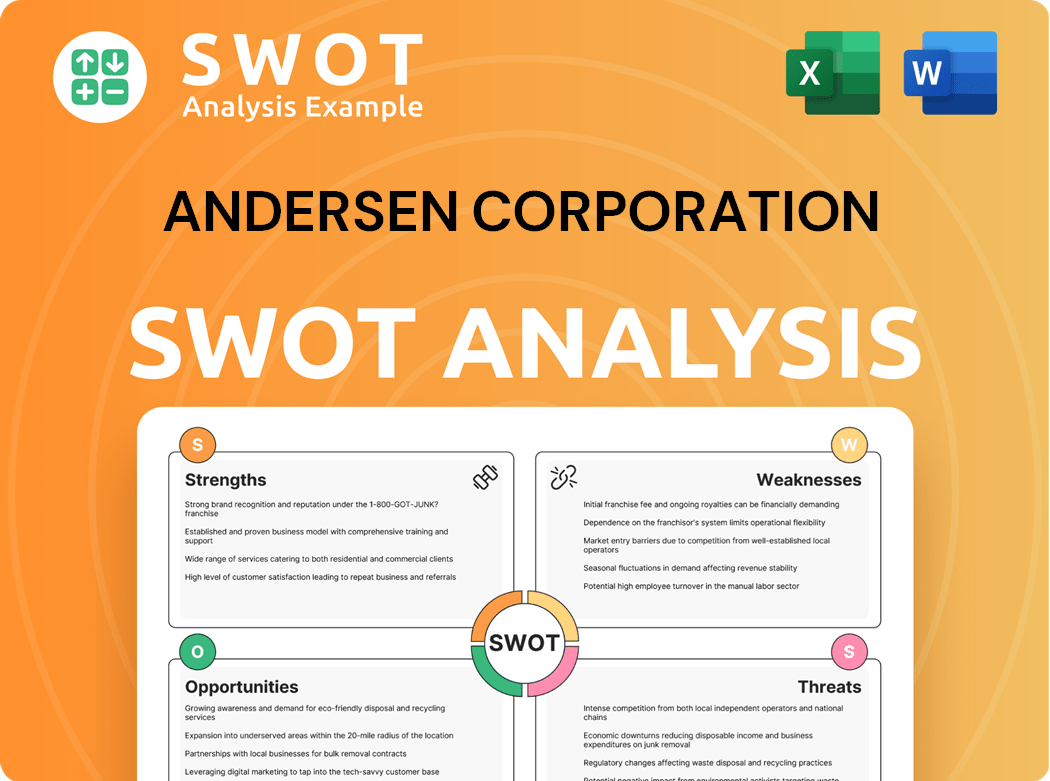
How Has Andersen Corporation’s Ownership Changed Over Time?
The ownership of Andersen Corporation, also known for its Andersen Windows products, has remained private throughout its history, primarily held within the Andersen family. This structure has enabled a focus on long-term strategies, differentiating it from publicly traded companies. A significant aspect of this ownership model is the long-standing commitment to employee ownership, a practice initiated in 1914.
In 2024, Andersen Corporation distributed a substantial $50.8 million in profit sharing to its 13,000 eligible employees. Each eligible employee received up to $3,923, highlighting the company's dedication to aligning employee interests with its performance. The company's revenue for 2024 was approximately $4.1 billion. This private ownership model has likely contributed to its stable strategic direction and focus on product innovation, such as the introduction of Fibrex material for its windows, which contributed significantly to its 2024 revenue.
| Aspect | Details | Impact |
|---|---|---|
| Ownership Structure | Private, primarily family-owned with significant employee profit-sharing. | Enables long-term strategic focus, shields from short-term market pressures. |
| Employee Ownership | Profit-sharing programs dating back to 1914; 2024 distribution of $50.8 million. | Aligns employee interests with company performance, fostering a dedicated workforce. |
| Financial Performance | 2024 revenue of approximately $4.1 billion. | Supports continued innovation and market presence. |
The private nature of the company means that specific ownership percentages are not publicly disclosed beyond the historical 27% employee stock. The sustained private ownership of Andersen Corporation has likely contributed to its stable strategic direction and focus on product innovation. To understand the competitive environment, it's helpful to consider the Competitors Landscape of Andersen Corporation.
Andersen Corporation's ownership is primarily within the Andersen family, operating as a private company. This structure allows for a long-term strategic focus, unlike public companies. Employee profit-sharing is a significant part of the ownership model, aligning employee interests with company success.
- Private ownership structure.
- Significant employee profit-sharing.
- Focus on long-term strategies.
- 2024 revenue of approximately $4.1 billion.
Andersen Corporation PESTLE Analysis
- Covers All 6 PESTLE Categories
- No Research Needed – Save Hours of Work
- Built by Experts, Trusted by Consultants
- Instant Download, Ready to Use
- 100% Editable, Fully Customizable
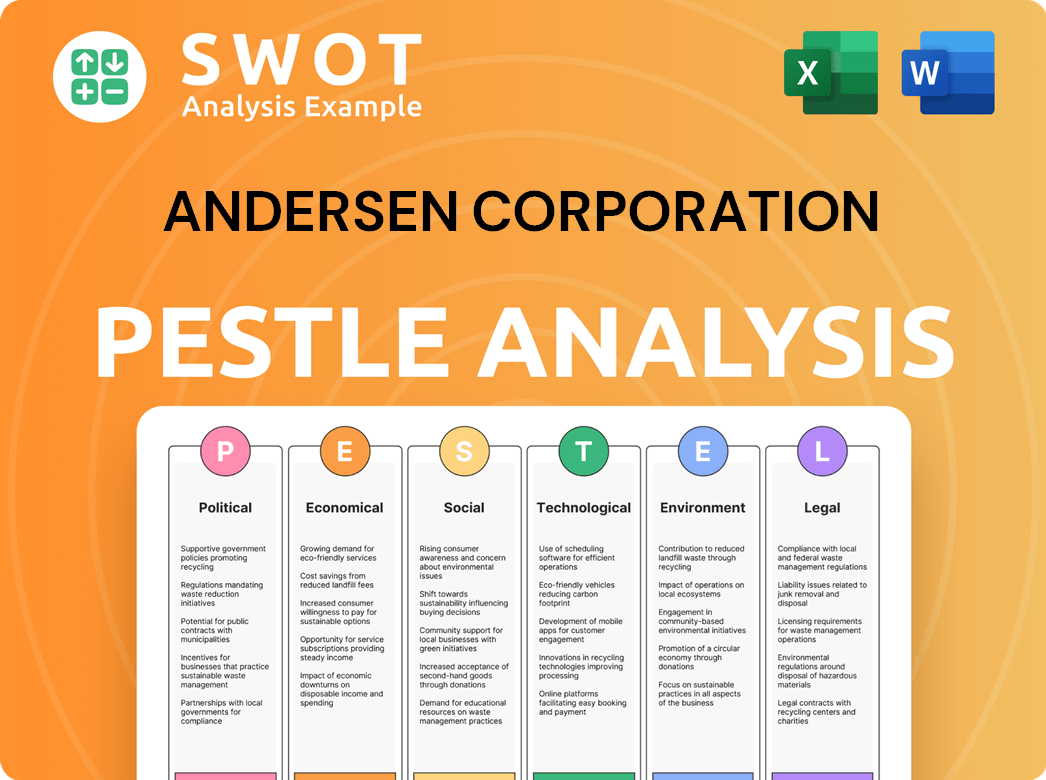
Who Sits on Andersen Corporation’s Board?
As a privately held entity, the board of directors at Andersen Corporation, which dictates the strategic direction, is structured in a way that reflects its ownership. While specific details about the board members and their ownership representations are not publicly available, it's known that key leadership roles are represented. For example, Chris Galvin, who became President and CEO in 2023, was appointed Chairman of the board in March 2025. He took over from Jay Lund, who retired in 2022 after a long tenure and had been chairman since 2013. Donald Allan, Jr. serves as the lead independent director.
The composition of the board suggests a focus on long-term stability and the company's core values, considering its history of family ownership and significant employee stock holdings through profit-sharing. The appointment of internal leaders like Chris Galvin as chairman indicates a continuation of leadership that understands the company's culture and private ownership model. This structure is typical for a privately held company with a stable ownership base. To further understand the company's approach, you can explore the Growth Strategy of Andersen Corporation.
| Board Member | Title | Notes |
|---|---|---|
| Chris Galvin | Chairman of the Board, President and CEO | Appointed Chairman in March 2025 |
| Donald Allan, Jr. | Lead Independent Director | Oversees independent board matters |
| Jay Lund | Former Chairman | Retired in 2022 after 37 years |
The voting structure, common in private companies, isn't publicly detailed. Given the company's history and employee stock holdings, it's likely designed to ensure long-term stability. There have been no recent public reports of proxy battles or governance controversies, which is typical for a privately held company. The focus remains on sustainable growth and maintaining the company's private status.
The board of directors at Andersen Corporation includes key figures like the Chairman, President, and CEO, Chris Galvin, and the Lead Independent Director, Donald Allan, Jr.
- Chris Galvin became Chairman in March 2025.
- Donald Allan, Jr. is the Lead Independent Director.
- The company's leadership structure supports its long-term strategy.
- Andersen Corporation's ownership is a key factor in its governance.
Andersen Corporation Business Model Canvas
- Complete 9-Block Business Model Canvas
- Effortlessly Communicate Your Business Strategy
- Investor-Ready BMC Format
- 100% Editable and Customizable
- Clear and Structured Layout
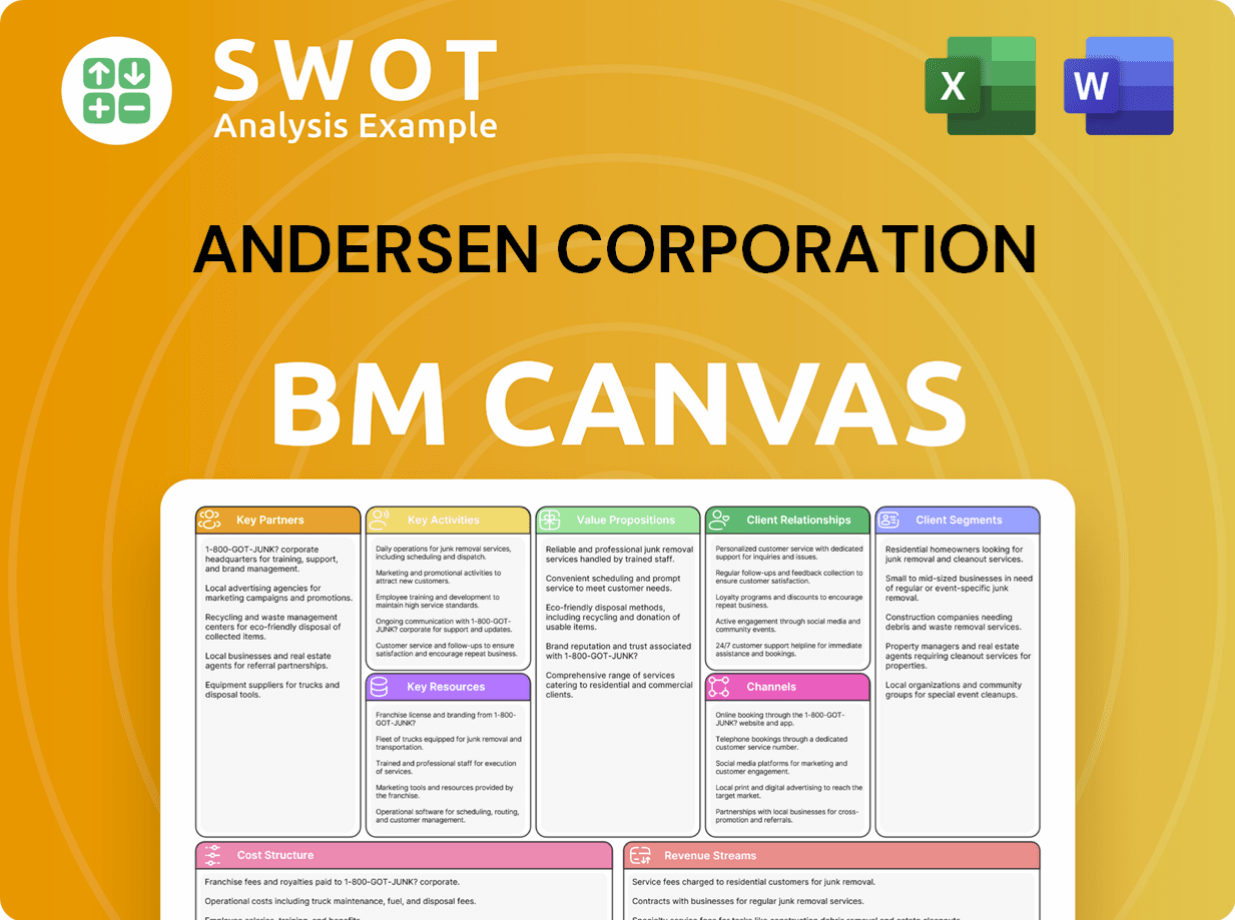
What Recent Changes Have Shaped Andersen Corporation’s Ownership Landscape?
Over the past few years, the focus for Andersen Corporation ownership has been on maintaining its private structure and reinforcing its employee-centric model. In December 2024, the company distributed a profit-sharing of $50.8 million to eligible employees, with potential payouts of up to $3,923 per employee. This practice, which dates back to 1914, highlights a continued commitment to employee contributions and aligning their interests with the company's success.
In March 2025, Chris Galvin, who has been the President and CEO since 2023, was appointed Chairman of the Board of Directors, succeeding Jay Lund. Furthermore, in August 2024, George Bandy was appointed as the new Vice President and Chief Sustainability Officer, indicating a strategic focus on sustainability. While the industry has seen trends such as institutional ownership and consolidation, particularly in Europe's M&A and private equity landscape in Q1 2024, Andersen's ownership structure has remained consistent, allowing it to maintain its distinct corporate culture and long-term vision.
| Metric | Value | Year |
|---|---|---|
| Revenue | Approximately $4.1 billion | 2024 |
| North American Market Share (Premium Windows & Doors) | Approximately 20% | 2024 |
| Employee Profit Sharing Distribution | $50.8 million | December 2024 |
| Maximum Employee Profit Share | $3,923 per employee | December 2024 |
The company's 2024 revenue was approximately $4.1 billion, and it holds a strong market share, estimated at 20% in the premium window and door segment in North America. There have been no public statements regarding potential privatization or public listing, which reinforces its commitment to remaining a private entity. For a deeper dive into the company's strategies, you can also explore the Marketing Strategy of Andersen Corporation.
The primary owner of Andersen Windows is Andersen Corporation itself, a privately held company. This structure allows for a focus on long-term strategies and employee benefits.
Andersen Corporation serves as its own parent company, maintaining direct control over its operations and strategic decisions. This structure allows for efficient management.
Andersen Windows is a major player in the window and door industry, known for its quality and innovation. The company's commitment to sustainability and employee welfare sets it apart.
The ownership structure of Andersen Windows is private, with a focus on employee profit-sharing. This structure enables the company to prioritize long-term goals and employee benefits.
Andersen Corporation Porter's Five Forces Analysis
- Covers All 5 Competitive Forces in Detail
- Structured for Consultants, Students, and Founders
- 100% Editable in Microsoft Word & Excel
- Instant Digital Download – Use Immediately
- Compatible with Mac & PC – Fully Unlocked
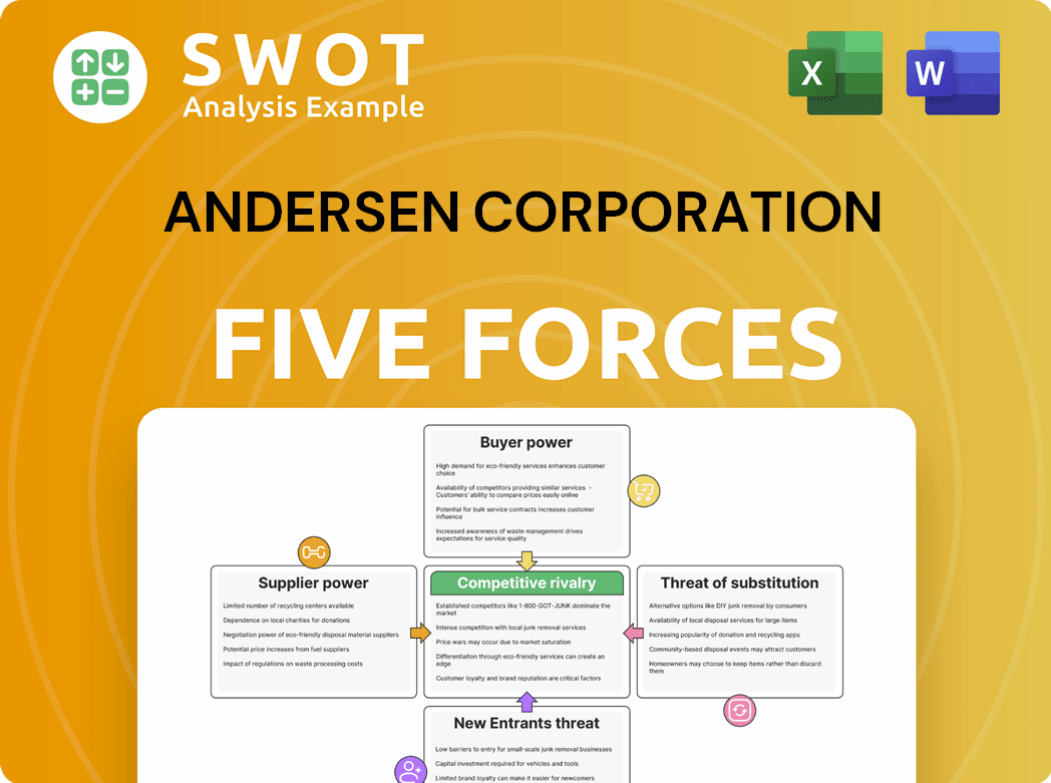
Related Blogs
- What are Mission Vision & Core Values of Andersen Corporation Company?
- What is Competitive Landscape of Andersen Corporation Company?
- What is Growth Strategy and Future Prospects of Andersen Corporation Company?
- How Does Andersen Corporation Company Work?
- What is Sales and Marketing Strategy of Andersen Corporation Company?
- What is Brief History of Andersen Corporation Company?
- What is Customer Demographics and Target Market of Andersen Corporation Company?
Disclaimer
All information, articles, and product details provided on this website are for general informational and educational purposes only. We do not claim any ownership over, nor do we intend to infringe upon, any trademarks, copyrights, logos, brand names, or other intellectual property mentioned or depicted on this site. Such intellectual property remains the property of its respective owners, and any references here are made solely for identification or informational purposes, without implying any affiliation, endorsement, or partnership.
We make no representations or warranties, express or implied, regarding the accuracy, completeness, or suitability of any content or products presented. Nothing on this website should be construed as legal, tax, investment, financial, medical, or other professional advice. In addition, no part of this site—including articles or product references—constitutes a solicitation, recommendation, endorsement, advertisement, or offer to buy or sell any securities, franchises, or other financial instruments, particularly in jurisdictions where such activity would be unlawful.
All content is of a general nature and may not address the specific circumstances of any individual or entity. It is not a substitute for professional advice or services. Any actions you take based on the information provided here are strictly at your own risk. You accept full responsibility for any decisions or outcomes arising from your use of this website and agree to release us from any liability in connection with your use of, or reliance upon, the content or products found herein.